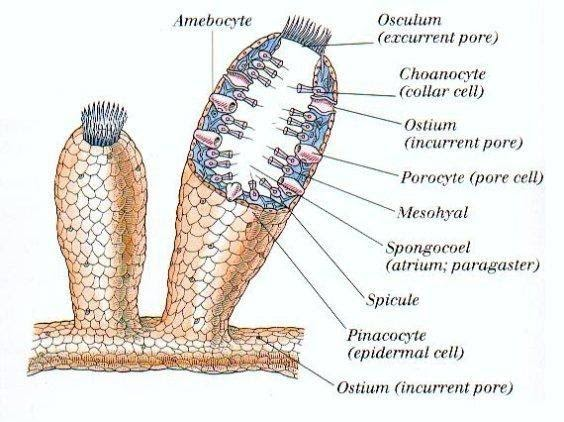
Porifera is triploblastic or diploblastic?
Answer
380.4k+ views
Hint: Members of the phylum Porifera, sponges are multicellular organisms with holes and channels that allow water to flow through them. Their bodies are made up of jelly-like mesophyll placed in between the two thin layers of cells. Spongiology is the discipline of zoology that examines sponges.
Complete answer:
Sponge is the common name for poriferans. The phylum Porifera, which includes roughly 5,000 living sponge species, is divided into three groups : the Hexactinellida (glass sponges), Demospongia and Calcarea (calcareous sponges).
Porifera are mostly marine aquatic animals, with a few freshwater species thrown in for good measure. They have asymmetrical bodies.
Cylindrical, vase-like, spherical, or sac-like body shapes are all possible. They have two layers, the outer dermal layer and the inner gastro layer, and hence are diploblastic creatures.
Distinguished by a feeding strategy that is unique among animals, the poriferans don't have a mouth system; instead water is sucked through microscopic holes or pores found in their exterior walls. As the water is circulated through the body and out of the other larger apertures, cells in the sponge walls sift out the good stuff. Sponge cells execute a wide range of biological tasks and appear to be more self-contained than other animal cells.
Note:
A blastula is a spherical, hollow, one cell thick structure seen at the initial stage of embryogenesis and is known as the 'pre-embryo'. Diploblastic and triploblastic refer to two different varieties of blastula stages. Diploblastic and triploblastic animals vary where the diploblastic animals develop two germ layers (excluding mesoderm), whereas triploblastic animals create all three germ layers. Image of a Phylum Porifera is as follows:

Complete answer:
Sponge is the common name for poriferans. The phylum Porifera, which includes roughly 5,000 living sponge species, is divided into three groups : the Hexactinellida (glass sponges), Demospongia and Calcarea (calcareous sponges).
Porifera are mostly marine aquatic animals, with a few freshwater species thrown in for good measure. They have asymmetrical bodies.
Cylindrical, vase-like, spherical, or sac-like body shapes are all possible. They have two layers, the outer dermal layer and the inner gastro layer, and hence are diploblastic creatures.
Distinguished by a feeding strategy that is unique among animals, the poriferans don't have a mouth system; instead water is sucked through microscopic holes or pores found in their exterior walls. As the water is circulated through the body and out of the other larger apertures, cells in the sponge walls sift out the good stuff. Sponge cells execute a wide range of biological tasks and appear to be more self-contained than other animal cells.
Note:
A blastula is a spherical, hollow, one cell thick structure seen at the initial stage of embryogenesis and is known as the 'pre-embryo'. Diploblastic and triploblastic refer to two different varieties of blastula stages. Diploblastic and triploblastic animals vary where the diploblastic animals develop two germ layers (excluding mesoderm), whereas triploblastic animals create all three germ layers. Image of a Phylum Porifera is as follows:

Recently Updated Pages
Master Class 11 Accountancy: Engaging Questions & Answers for Success

Glucose when reduced with HI and red Phosphorus gives class 11 chemistry CBSE

The highest possible oxidation states of Uranium and class 11 chemistry CBSE

Find the value of x if the mode of the following data class 11 maths CBSE

Which of the following can be used in the Friedel Crafts class 11 chemistry CBSE

A sphere of mass 40 kg is attracted by a second sphere class 11 physics CBSE

Trending doubts
10 examples of friction in our daily life

Difference Between Prokaryotic Cells and Eukaryotic Cells

State and prove Bernoullis theorem class 11 physics CBSE

What organs are located on the left side of your body class 11 biology CBSE

Define least count of vernier callipers How do you class 11 physics CBSE

The combining capacity of an element is known as i class 11 chemistry CBSE




